CityTouring

City trip to Venice
ItalyVenice, a city in northeastern Italy, is famous for its canals, which flow like arteries through the city, creating a unique, floating infrastructure. Built on over 100 small islands in a lagoon in the Adriatic Sea, it boasts an enchanting combination of Gothic, Renaissance, and Byzantine architecture. Visitors are drawn to its labyrinth of narrow, cobblestone streets and romantic waterways where gondolas glide smoothly. Highlights include the iconic St. Mark's Basilica, with its stunning mosaics and the grand Doge's Palace, both located in the historic St. Mark's Square.
Art enthusiasts will appreciate the Peggy Guggenheim Collection and Gallerie dell'Accademia, while those with a taste for opera should not miss a performance at the famous Teatro La Fenice. Venice also hosts the annual Venice Film Festival, a prestigious event that further accentuates its cultural significance. Visitors can indulge in Venetian cuisine at local eateries, savoring fresh seafood and traditional cicchetti.
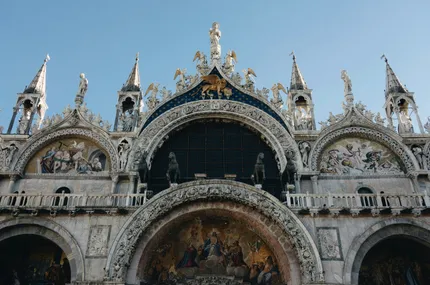
San Marco Basilica
Stunning Italo-Byzantine architecture and opulent design make this basilica Venice's most iconic religious building, located on the renowned Piazza San Marco.

Grand Canal
The central waterway of Venice, the Grand Canal winds through the city. It offers stunning views of Venetian architecture and vibrant daily life.
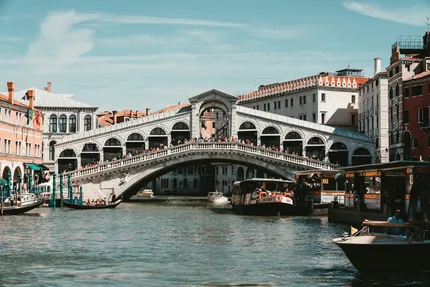
Rialto Bridge
One of the oldest and most famous bridges spanning the Grand Canal, it's a vital pedestrian thoroughfare and a perfect spot for picturesque views.
Venice is an ideal destination for travelers captivated by history, architecture, and art. Its romantic atmosphere makes it a perfect getaway for couples seeking a picturesque and unique escape. Cultural enthusiasts and art lovers will find the wealth of museums and historic sites riveting. Additionally, its unique canal system offers one-of-a-kind experiences for adventurers willing to explore by gondola or water taxi. The local cuisine, rich in seafood and traditional Italian flavors, caters well to foodies.
However, the city might not be the best fit for those looking for a high-paced nightlife, as its offerings in this area is limited. It is a popular option to combine a trip to Venice with a beach holiday on a nearby beach on the Italian Mainland, for example in Lido di Jesolo or on Lido itself, a neighboring island of Venice. Families with children might find the city less accommodating due to its intricate waterways and the need for a lot of walking to explore the pedestrian-friendly streets. Overall, Venice provides a fascinating experience for those interested in European culture and history and those looking to combine a trip to a historic city with a beach vacation nearby.
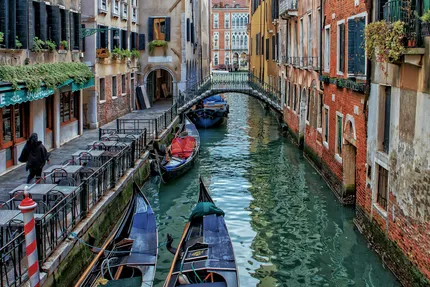
Best time to visit Venice
The best time to visit Venice is during the shoulder seasons of spring (April to June) and early autumn (September to October) when the weather is pleasant, and crowds are less intense.
More activities and things to see in Venice:
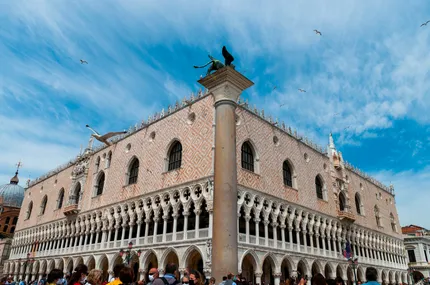
Doge's Palace
A Gothic masterpiece facing the lagoon, this palace tells the history of Venice's rulers with lavish rooms and an impressive art collection.
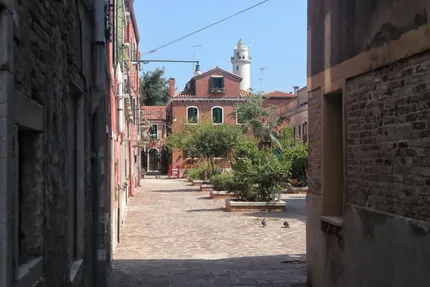
Murano Island
Renowned for exquisite glassmaking, visitors can tour factories and admire or purchase intricate glass art in this quaint island town.

Burano Island
A picturesque escape famous for its brightly colored fishermen's houses and intricate lace-making, ideal for a day trip and photography enthusiasts.
Peggy Guggenheim Collection
Showcases an impressive assortment of modern art, featuring works by Picasso, Pollock, and Kandinsky in a palatial setting along the Grand Canal.
Teatro La Fenice
One of Italy's most celebrated opera houses, offering stunning performances and a majestic glimpse into Venetian cultural heritage.
Scuola Grande di San Rocco
Features impressive Tintoretto paintings and ornate architecture, a cultural gem showcasing Venice's artistic richness.
Venice Lido
An island known for its sandy beaches and as the site of the Venice Film Festival, offering a relaxing retreat from Venice's bustling center.
Getting around in Venice
Venice is a unique city where cars are not allowed, making walking the primary way to explore its charming streets and canals. The city's intricate network of narrow alleyways and picturesque bridges connects its many districts, providing an ideal setting for pedestrians. Apart from walking, the Vaporetto, or water bus, is an efficient way to navigate the Grand Canal and reach outlying islands like Murano and Burano. Gondolas and water taxis offer more private but costly options. Bicycles are not permitted in the main parts of Venice, maintaining the pedestrian-focused environment. Public transport is generally reliable, though it can be crowded during peak tourist seasons. Exploring Venice by foot, combined with occasional water transport, offers an intimate view of its historic architecture and vibrant culture.
Getting to Venice
Venice is accessible via Marco Polo Airport, approximately 13 kilometers from the city center. The airport hosts numerous international flights, making it a convenient entry point for travelers. A short water taxi ride can take you directly to Venice, while buses connect the airport to Piazzale Roma on the mainland. Alternatively, flying into Treviso Airport is another option, located about 40 kilometers away, often serving budget airlines. For those preferring trains, Venice's Santa Lucia station connects with major Italian cities like Milan, Rome, and Florence, as well as international destinations through high-speed and regional services. Long-distance buses also serve the Tronchetto bus terminal, offering connections to various European locations. Integrating air, train, and bus travel options provides flexible and diverse routes to reach the enchanting city of Venice.